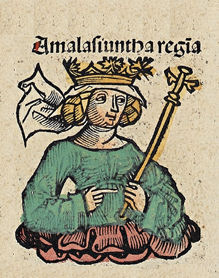535
Murder of Amalasuntha
One of the tragedies surrounding the fall of the Roman Empire in the West is the fact that it needn’t have been so catastrophic. The Ostrogoths who had invaded Italy and deposed the last of the western emperors in 476 were anxious to keep their territory peaceful and functioning — otherwise how could the population support their Germanic occupiers in the manner to which they would like to become accustomed? Under their king Theoderic (454-526), the trappings of civilization were maintained; using Roman administrators, they collected taxes, dredged the harbours, maintained trade, and kept the roads clear of bandits. Libraries were open, Christian worship (both Catholic and Arian) proceeded unmolested. However, in his last years, Theoderic lost faith in his Roman ruling class and executed a number of them for conspiring with the Eastern Roman empire in Constantinople.
Had Theoderic died with an adult male heir, things might yet have continued in a peaceful manner, but his only surviving child was a daughter Amalasuntha (495-535) and so the crown went to her ten-year-old son Athalaric, for whom she served as regent. Amalasuntha seems to have been well-educated in the traditional Roman manner, speaking Gothic, Latin and Greek, and she was certainly a friend both of her Roman administrative class and the eastern empire: a fact that vexed some traditionalist Gothic nobles. When her son died in 534, she shared her reign with her cousin Theodahad, believing that a male of the warrior class would lend her regime some authority. It was a fatal mistake — Thedodahad exiled Amalasuntha and had her murdered in her bath. This prompted a struggle for the crown; in the ensuing civil strife Theodahad was himself killed but, more importantly, the eastern empire was given an excuse to intervene.
The ensuing Gothic wars that began with the invasion of an eastern army under Belisarius went on for over twenty years and ended in Italy being ravaged in a worse fashion than the barbarian incursions had produced. The weakened Gothic and eastern forces were finally in no state to resist yet another wave of barbarians, the Lombards, who further devasted the peninsula.
